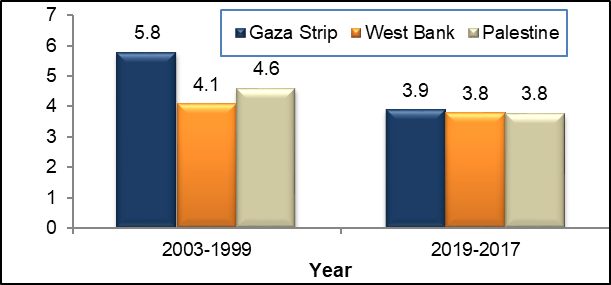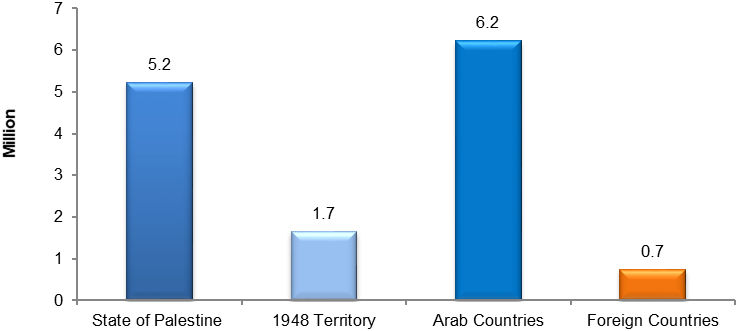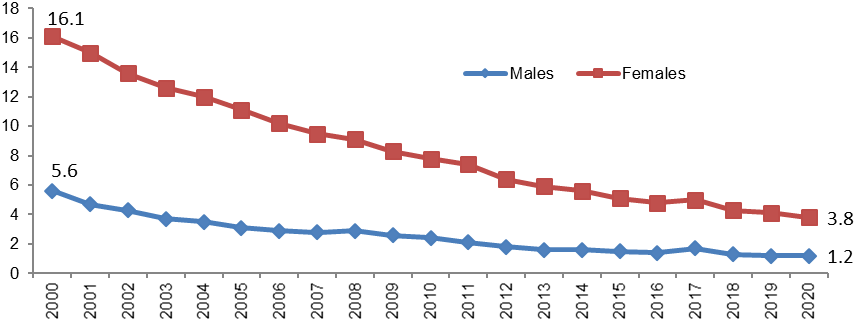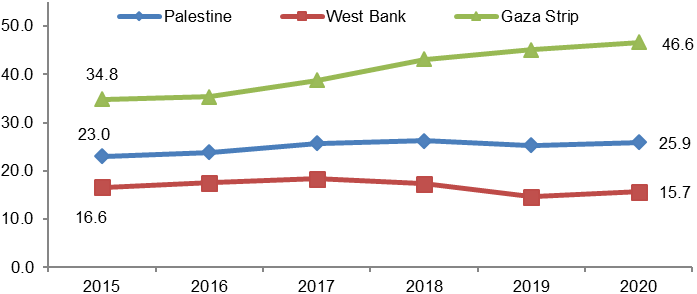Palestinian Central Bureau of Statistics (PCBS) and the United Nations Population Fund (UNFPA)
The Palestinian Central Bureau of Statistics (PCBS) and the United Nations Population Fund (UNFPA) jointly issue a press release on the Occasion of the International Population Day 11/07/2021, the world celebrates the World Population Day Under the theme "Protecting women's health and rights by reducing COVID-19"
The world celebrates the World Population Day on July 11th each year since 1990, in order to promote awareness of population issues and its relationship to the environment and development, given the consequences of the COVID-19 pandemic on all countries and its direct impact on women, who are more vulnerable to the risks
of COVID - 19.
About 13.8 Million Palestinians in Historical Palestine and Diaspora
Based on population estimates prepared by PCBS, there are about 13.8 million Palestinians in the world in mid-2021, of whom about 5.23 million in the State of Palestine; 2.66 million males and 2.57 million females. The estimated population of the West Bank was 3.12 million, of whom 1.59 million males and 1.53 million females. While the estimated population of Gaza Strip was 2.11 million in the same year; of whom 1.07 million males and 1.04 million females.
Number of the Palestinian Population by Country of Residence, Mid-2021
|
|
Source: Palestinian Central Bureau of Statistics, 2021. Revised Estimated based on the final results of Population, Housing and Establishments Census, 2017. Ramallah – Palestine
The Palestinian Population is Young; more than One-third of the Population is Less than 15 Years
The percentage of individuals aged (0-14) years constituted 38% of the total population in mid-2021; of whom 36% in the West Bank and 41% in Gaza Strip. The percentage of elderly population aged (65 years and above) reached 3% of the total population; of whom 4% in the West Bank and 3% in Gaza Strip in mid-2021.
Crude Birth Rates are Higher in Gaza Strip than in the West Bank
Population projections revealed that crude birth rate in Palestine was 29.5 births/1000 of the population in 2021. The results showed that this rate was 27.2 births in the West Bank compared to 32.9 births/1000 of the population in Gaza Strip. The estimated crude death rate in Palestine was 3.7 deaths/1000 of the population, where this rate in the West Bank was 3.9 deaths/1000 of the population compared to 3.4 deaths/1000 of the population in Gaza Strip.
A Decline in Fertility Rates
The total fertility rate during (2017 – 2019) has declined to reach 3.8 births, compared to 4.6 births during the period (1999-2003); 3.8 births in the West Bank and 3.9 births in Gaza Strip. On the other hand, fertility rate was 3.8 births in urban areas compared to 4.4 births in rural areas and 3.5 births in the Palestinian refugee camps.
Fertility Rate in the State of Palestine, Selected Years

Source: Palestinian Central Bureau of Statistics, 2021. Database of the Demographic and Health Survey, 2004. Ramallah - Palestine.
Source: Palestinian Central Bureau of Statistics, 2021. Database of the Palestinian Multiple Indicator Cluster Survey 2019-2020. Ramallah - Palestine.
13% of women in Palestine have unmet need for family planning
Data of the Palestinian Multiple Indicator Cluster Survey 2019-2020 (PMICS6) indicated that the percentage of women in the age group (15-49 years) who are currently married, who are able to have children and who wish to space their pregnancies, or reduce the number of children and do not use any means of family planning in Palestine reached 13%; (14% in the West Bank compared to 12% in Gaza Strip).
95% of women in Palestine received prenatal health care
Results of the PMICS6 )2019-2020( showed that about 95% of women aged 15-49 years received prenatal health care at least four times by a health care provider during pregnancy; and about 73% of women in the same age received health care eight times or more during pregnancy.
Constant Decline in the Average Household Size
The results of both the Labor Force Survey, 2020 and the Population, Housing and Establishments Census, 2017 indicated a decline in the average household size in Palestine compared to 2007. Thus, the average size of the household declined to 5.1 individuals in 2020 compared to 5.8 individuals in 2007. On the other hand, the average household size in the West Bank declined to 4.7 individuals in 2020 compared to 5.5 individuals in 2007. In Gaza Strip, the average household size declined to 5.7 in 2020 compared to 6.5 in 2007.
The Average Household Size in Palestine by Region, Selected Years
|
|
Source: Palestinian Central Bureau of Statistics, 2021. Estimates based on the results of the Labor Force Survey and on the final results of Population, Housing and Establishments Census, 2007, 2020. Ramallah - Palestine.
One out of ten Households is Headed by a Female
Results of the Labor Force Survey, 2020 showed that 11% of the households were headed by females in Palestine (12% in the West Bank and 9% in Gaza Strip).
Low Illiteracy Rate in Palestine
The Labor Force Survey 2020 data showed that illiteracy rate among individuals (15 years and above) in Palestine was 2.5%. The illiteracy gap is significantly noticed among males and females with percentages of 1.2% and 3.8%, respectively.
Illiteracy Rates among Palestinian Population (15 years and above) in Palestine by Sex:
2000-2020
|
|
Source: Palestinian Central Bureau of Statistics, 2021. Database of the Labor Force Survey 2007-2020. Ramallah - Palestine.
About One-fourth of the Labor Force Participants were Unemployed
Results also showed that more than one-fourth of the participants in the labour force were unemployed in 2020, where the percentage reached 26% (16% in the West Bank and 47% in Gaza Strip). Accordingly, unemployment rate reached 40% among females compared to 23% among males.
Unemployment Rate among Labour Force Participants (15 years and above) in Palestine by Region: 2015-2020
|
|
Source: Palestinian Central Bureau of Statistics, 2021. Database of the Labor Force Survey, 2020. Ramallah - Palestine.
About 80% of Palestinian Households Have Access to Internet at Home
Results of the Household Survey on Information and Communications Technology, 2019 showed that 80% of the households in Palestine have internet access at home (84% in the West Bank and 73% in Gaza Strip). While the percentage of individuals aged (10 years and above) who used the internet from anywhere reached 71% in Palestine (74% in the West Bank and 65% in Gaza Strip).
Data also showed that the percentage of males who used internet reached 72% compared to 69% for females. Data also showed that the percentage of households that own one smartphone or more was 86% in Palestine (91% in the West Bank and 78% in Gaza Strip). Moreover, the results of the survey showed that the percentage of individuals aged (10 years and above) who own a cellular mobile was 75% in Palestine (82% in the West Bank and 64% in Gaza Strip); 79% for males and 71% for females.
29% of the households in which at least one of their members, who was infected with COVID-19, has experienced bullying
Results of the COVID-19 Survey showed that 85% of Palestinian households expressed their concern about catching the infection of COVID-19 (of whom 35% were very worried about the infection), knowing that 15% of the households confirmed that at least one of them was infected with COVID-19, and 29 % of the households in which at least one member was infected with COVID-19 confirmed that their infected household members were bullied.
Less than half of those who were infected with COVID – 19 have visited a COVID-19 specialized health center
As for the measures taken in case of infection with the COVID-19, results showed that 96% of the infected people adhered/committed to the home quarantine, 80% took only vitamins/antibiotics but without referring to any health center, 83% took only medical herbs but without referring to any health center, while 29% visited a public health center that was not specialized in COVID-19, and 48% visited a COVID-19 specialized health center.
29% of people infected with COVID- 19 have caught the infection when visiting family and friends
The results of the COVID-19 Survey showed that 29% of those infected with COVID-19 caught the infection when visiting family and friends, 22% from work, 10% from attending a wedding or a funeral, 9% from hospitals and health care centers, and 7% from universities and schools. On the other hand, 18% of the infected persons do not know from where they or their family members caught COVID-19.
In the same context, the results of the COVID – 19 Survey indicated that 21% of pregnant women needed prenatal health care, but couldn’t receive it during their pregnancy due to the COVID -19 pandemic during the period of March 3rd and up to May 25th, 2020. While 9% of the women didn’t receive any health care services after birth delivery during the same mentioned period.







